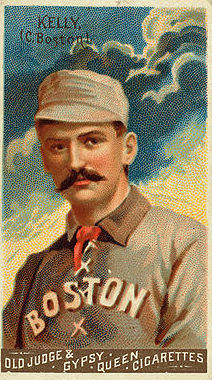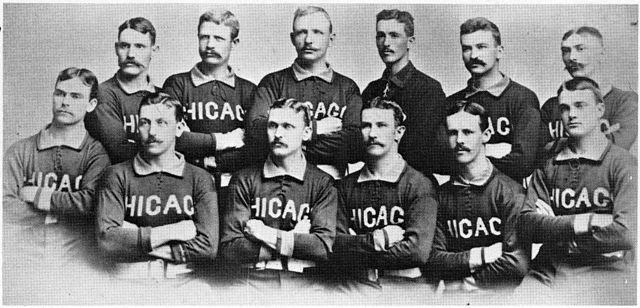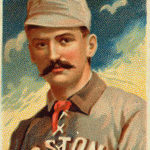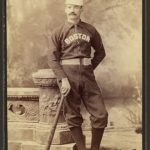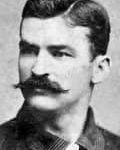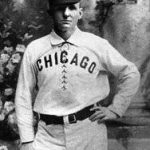King Kelly Stats & Facts
King Kelly Essentials
Positions: Outfield, Catcher, Manager
Bats: R Throws: R
Height: Weight: 170
Born: December 31, 1857, in Troy, NY.
Died: November 8, 1894 in Boston, MA USA
Debut: May 1, 1878
Last Game: September 2, 1893
Hall of Fame: Inducted as a Player in 1945 by Old Timers
Full Name: Michael Joseph Kelly
Players Who Debuted Same Year
Coming Soon
All-Time Teammate Team
Coming Soon
Notable Events and Chronology
King Kelly Essentials
King Kelly was the toast of baseball in the late 1870s and 1880s, establishing himself as the number one drawing card in the sport. He helped the White Stockings to five National League championships, managed the Boston Reds of the rebel Players League to a title, and at the age of 34 he caught for Frank Selee’s pennant-winning 1892 Boston Beaneaters. Though he was known for his base running prowess (“Slide Kelly Slide!”), he never led his league in steals. He was the most flamboyant performer of his time, and until Babe Ruth came along, Kelly was the most popular player in baseball. Kelly subverted the playing rules as much as he could, finding ways to create daring maneuvers, including perfecting the hit-and-run play. With the White Stockings (the forerunners of the Cubs), he and Cap Anson devised many of the strategies that later became staples of the game, such as playing off the base at first and third, adjusting the outfielders for hitters tendencies, the infield shift, and the double steal.
Best Season: 1886
Kelly led the National League with a .388 average, 155 runs scored, and a .483 on-base percentage. Despite his efforts, he was shipped to Boston in the off-season.
“The $15,000 Beauty”
Handsome Michael Joseph “King” Kelly was adored by the fans of Chicago, and he became a legend. Spurred by his exploits, the White Stockings won titles in 1880, 1881, 1882, 1885 and 1886, with primarily the same lineup: Kelly in right field; Cap Anson (like Kelly, a future Hall of Famer) manning first base; Silver Flint at catcher; light-hitting Joe Quest or Tom Burns or Fred Pfeffer (whom both Anson and Kelly called the greatest second baseman they ever saw) at the keystone; Ned Williamson at third base; Abner Dalrymple (who once clubbed 22 homers in a season) in left; George “Piano Legs” Gore in center field; and the able Larry Corcoran, Fred Goldsmith and John Clarkson (future Hall of Famer) on the slab. The White Stockings were the greatest team in the National League until the Beaneaters of the late 1880s and early 1890s, and the Baltimore Orioles of the 1890s.
Kelly and the rest of the White Stockings were rough guys with a reputation for bending the rules, both on and off the field. In fact, Kelly had a clause in his contract rewarding him if he stayed out of trouble. After helping Chicago to its’ fifth NL pennant in seven years in 1886, batting champion Kelly met with Chicago owner Albert Spalding, the man who would later spawn the sporting goods company that bore his name. Kelly demanded that Spalding pay him a $375 bonus that he was promised for “good behavior.” Surprised by the demand, Spalding argued he was not obligated to pay Kelly the bonus because the outfielder had been fined several times for drunken behavior. After a few days of dragging each other through the Chicago papers, Spalding shocked the Windy City by selling his star to the Boston Beaneaters for a record $10,000. Fans were so upset that they refused to attend the White Stockings home opener, leaving attendance at an embarrassingly low level. Yet when the Beaneaters later visited Chicago, fans flocked to see their favorite player in an enemy uniform. Because he had been sold for $10,000 and reportedly been paid a $5,000 bonus by the Beaneaters, Kelly became known as “The $15,000 Beauty.”
Where He Played
Kelly was primarily a right fielder, though he also played frequently in left field. Kelly played every position during his career, even pitcher.
As a Manager
Kelly was 130-91 (.588) as a manager, winning the Players League championship in 1890 with the Reds. Dan Brouthers, Billy Nash, Hardy Richardson and Charley “Old Hoss” Radbourn played for him on that team. Despite the fact that Kelly was the best player on the team, he played himself only part-time, batting .326 in 89 games.
Slide, Kelly, Slide!
The song, “Slide, Kelly, Slide” was America’s first “pop hit” record, after its release by Edison Studios, and in 1927 inspired a film version of Slide, Kelly, Slide. Prior to that song, most recordings (cylinders), were opera, religious or patriotic in nature. Kelly is also considered to have been the first man to popularize autographing, as fans pursued him on his way to the ballpark for his signature in the 1890s. Prints of a painting of him sliding into second hung in most Irish saloons in Boston, and he was among the first athletes to perform on the vaudeville stage. His own autobiography, Play Ball, was the first written by a baseball player. The book was put together by Boston Globe reporter John Drohan.
Howard W. Rosenberg’s 2004 biography of Kelly dispelled any notion that Boston reporter Jake Morse had been the ghostwriter, by quoting Drohan’s involvement with the book at length, including unearthing the following sentence from a biography of Drohan in an 1889 book about the Irish in Boston: “His only literary work outside of his newspaper was the preparation of M. J. Kelly’s book, ‘Play Ball.'”
@ET-DC@eyJkeW5hbWljIjp0cnVlLCJjb250ZW50IjoicG9zdF90YWdzIiwic2V0dGluZ3MiOnsiYmVmb3JlIjoiTGVhcm4gTW9yZSBhYm91dCB0aGUgdGVhbXMsIHBsYXllcnMsIGJhbGwgcGFya3MgYW5kIGV2ZW50cyB0aGF0IGhhcHBlbmVkIG9uIHRoaXMgZGF0ZSBpbiBoaXN0b3J5IC0gLSAtIC0gLSAtIC0gIiwiYWZ0ZXIiOiIiLCJsaW5rX3RvX3Rlcm1fcGFnZSI6Im9uIiwic2VwYXJhdG9yIjoiIHwgIiwiY2F0ZWdvcnlfdHlwZSI6InBvc3RfdGFnIn19@
Factoids, Quotes, Milestones and Odd Facts
Coming soon
Other Resources & Links
Coming Soon
If you would like to add a link or add information for player pages, please contact us here.

